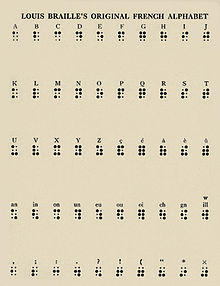Louis Braille
While still a student there, he began developing a system of tactile code that could allow blind people to read and write quickly and efficiently.Inspired by a system invented by Charles Barbier, Braille's new method was more compact and lent itself to a range of uses, including music.In adulthood, Braille served as a professor at the Institute and had an avocation as a musician, but he largely spent the remainder of his life refining and extending his system.Squinting closely at the surface, he pressed down hard to drive the point in, and the awl glanced across the tough leather and stabbed him in one of his eyes.A local physician bound and patched the affected eye and even arranged for Braille to be met the next day in Paris by a surgeon, but no treatment could save the damaged organ.[11] At that time the Royal Institute was an underfunded, ramshackle affair, but it provided a relatively stable environment for blind children to learn and associate together.He designed and manufactured a small library of books for the children by embossing heavy paper with the raised imprints of Latin letters.Because the raised letters were made in a complex artisanal process using wet paper pressed against copper wire, the children could not hope to "write" by themselves.So that the young Louis could send letters back home, Simon-René provided him with an alphabet made from bits of thick leather.[14] Nonetheless, Haüy's efforts still provided a breakthrough achievement – the recognition of the sense of touch as a workable strategy for sightless reading."It bears the stamp of genius," wrote Dr. Richard Slating French, former director of the California School for the Blind, "like the Roman alphabet itself".[31] Called decapoint, the system combined his method of dot-punching with a new specialized grill which Braille devised to overlay the paper.When used with an associated number table (also designed by Braille and requiring memorization), the grill could permit a blind writer to faithfully reproduce the standard alphabet.[32] After the introduction of decapoint, Braille assisted his friend Pierre-François-Victor Foucault, who invented the Raphigraphe, a device that allowed for more rapid creation of letters made with raised points.Fortunately, another teacher, Joseph Guadet, supported Braille, and the system was reintroduced in 1844, at the time of the opening of a new school building on the Boulevard des Invalides.However, by the time of the first all-European conference of teachers of the blind in 1873, the cause of braille was championed by Dr. Thomas Rhodes Armitage and thereafter its international use increased rapidly.[54][55] Because of his accomplishments as a young boy, Braille holds a special place as a hero for children, and he has been the subject of a large number of works of juvenile literature.




CoupvrayPanthéonBraillevisually impairedstitching awlharnessRoyal Institute for Blind YouthtactileCharles Barbieravocationhectaresvineyardcountrysideenterpriseleathererhorse tackSquintingstabbedphysiciansurgeonsympathetic ophthalmiapriestsNational Institute for Blind YouthValentin HaüyembossingLatin letterssense of touchorganistJean-Nicolas MarriguesCatholicChurch of Saint-Nicolas-des-ChampsChurch of Saint-Vincent-de-PaulFrench alphabetHis first versionslate and stylusCalifornia School for the Blindbraille musical notationdecapointPierre-François-Victor FoucaultWorld's FairtuberculosisThomas Rhodes Armitagebraille technologybraille computer terminalsRoboBrailleNemeth BrailleJean Perrinthe PanthéonT. S. Eliotlisted historic buildingasteroid9969 BrailleEncyclopædia BritannicaGoogle DoodleWorld Braille DayThom SoutherlandJérôme PradonCharing Cross TheatreBraille Authority of North AmericaEliot, T.S.ProQuestJernigan, KennethNational Federation of the BlindThe American PhilatelistSchmadel, Lutz D.large printJulian MessnerPerkins School for the Blind1829 brailleInternational uniformityASCII brailleUnicode braille patternsAlbanianAzerbaijaniCantoneseCatalanChinese (mainland Mandarin)EnglishUnified EnglishEsperantoFrenchGermanGhanaianGuaraniHawaiianHungarianIñupiaqItalianLatvianLithuanianLuxembourgishMalteseMāoriNavajoNigerianPhilippinePolishPortugueseRomanianSamoanSlovakSouth AfricanSpanishTaiwanese MandarinTurkishVietnameseYugoslavZambianEstonianFaroeseIcelandicScandinavianNorthern SámiCyrillicBelarusianBulgarianKazakhKyrgyzMongolianRussianUkrainianArabicPersianBharati BrailleDevanagari (Hindi / Marathi / Nepali)Bengali (Bangla / Assamese)